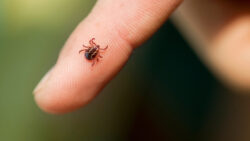Fleas and ticks are notorious pests that can cause significant discomfort for both pets and people. In Florida, where warm and humid conditions create an ideal environment for these pests, understanding the risks they pose and how to prevent them is crucial for maintaining a healthy home. In this comprehensive guide, we’ll explore whether fleas and ticks can get on humans, how to identify them, the health risks they pose, how they commonly enter homes, and effective prevention strategies.
Fleas vs. Ticks: Understanding the Differences
Before diving into the specifics of prevention and control, it’s essential to differentiate between fleas and ticks, as they have distinct characteristics and behaviors.
Fleas are small, wingless insects that are typically brownish-red and measure about 1/8 inch long. They have a flattened body, allowing them to navigate through the fur of animals easily. Fleas are known for their jumping ability and can leap up to 7 inches vertically. They feed on the blood of mammals and birds.
Ticks, on the other hand, are arachnids, related to spiders and scorpions. They have eight legs (as opposed to fleas’ six) and a flat, oval-shaped body that expands as they feed. Ticks are generally larger than fleas and can range from about 1/16 inch to 1/2 inch in size. They are typically found in wooded or grassy areas and attach themselves to hosts to feed on their blood.
Can Fleas and Ticks Get on Humans?
Fleas: Yes, fleas can get on humans. While fleas prefer to live on pets, they will jump onto humans if necessary, especially if there is a significant flea infestation in the home. Fleas are attracted to body heat and carbon dioxide, which are present in humans. When fleas bite humans, they cause itching and discomfort, often leading to red, inflamed welts.
Ticks: Ticks can also get on humans. They are known for attaching themselves to hosts, including humans, to feed on blood. Ticks often crawl onto humans when people walk through grassy or wooded areas where ticks are prevalent. Once attached, they can remain on their host for several days, making tick bites more concerning due to the potential transmission of diseases.
Health Risks of Fleas and Ticks
Both fleas and ticks pose significant health risks to humans and pets.
Fleas:
- Allergic Reactions: Flea bites can cause allergic reactions in some people and pets, leading to severe itching, redness, and swelling.
- Flea-borne Diseases: Fleas are known to transmit diseases such as typhus and tapeworms. While rare, these diseases can pose serious health risks.
- Secondary Infections: Excessive scratching of flea bites can lead to secondary bacterial infections.
Ticks:
- Lyme Disease: Ticks are well-known carriers of Lyme disease, which can cause symptoms such as fever, headache, fatigue, and a characteristic “bull’s-eye” rash. If left untreated, it can lead to severe health issues, including joint pain and neurological problems.
- Rocky Mountain Spotted Fever: This is a serious bacterial infection transmitted by ticks that can cause high fever, rash, and potentially life-threatening complications if not treated promptly.
- Anaplasmosis and Ehrlichiosis: These are other tick-borne diseases that can cause flu-like symptoms and, in severe cases, can be life-threatening.
How Fleas and Ticks Get into Your Home
Understanding how fleas and ticks enter your home can help you prevent infestations. Here are common ways these pests find their way inside:
Fleas:
- Pets: Pets are the primary carriers of fleas. Fleas can easily hitch a ride on your dog or cat and be brought into your home.
- Wildlife: Animals such as squirrels, raccoons, and opossums can carry fleas and introduce them to your property.
- Human Clothing: Fleas can also be transported indoors via human clothing or belongings if they have been in contact with infested areas.
Ticks:
- Outdoor Activities: Spending time in grassy or wooded areas can lead to ticks attaching themselves to your clothing or body, which they then bring indoors.
- Pets: Like fleas, ticks can attach to pets and be carried into the home.
- Wildlife: Wildlife, such as deer and rodents, can carry ticks and introduce them to your property.
Prevention Tips for Fleas and Ticks
Preventing fleas and ticks involves a combination of treatment for pets, home maintenance, and personal protection. Here are effective strategies:
Flea Prevention:
- Regular Pet Treatment: Use veterinarian-recommended flea and tick medicine for pets. Monthly topical treatments, oral medications, or flea collars can be effective in preventing fleas.
- Frequent Cleaning: Regularly vacuum carpets, rugs, and upholstery to remove flea eggs and larvae. Wash pet bedding and other fabrics in hot water.
- Yard Maintenance: Keep your yard well-maintained by trimming grass and removing leaf litter, which can serve as a habitat for fleas.
- Professional Pest Control: If you have a significant flea infestation, consider contacting a pest control company for professional treatment.
Tick Prevention:
- Personal Protection: When spending time outdoors, especially in wooded or grassy areas, wear long sleeves, pants, and tuck your pants into your socks. Use insect repellents that contain DEET on exposed skin.
- Tick Checks: After outdoor activities, thoroughly check yourself, your family members, and pets for ticks. Prompt removal of ticks can reduce the risk of disease transmission.
- Pet Treatment: Similar to flea prevention, use vet-approved tick prevention treatments for pets. Regularly check pets for ticks, especially after outdoor excursions.
- Yard Management: Create a tick-safe zone by keeping your yard free from tall grass and brush. Consider installing a tick barrier, such as a gravel or wood chip perimeter, to help reduce tick migration into your yard.
Fleas and ticks are more than just nuisances; they pose real health risks to humans and pets. By understanding the differences between fleas and ticks, recognizing the potential health risks, and implementing effective prevention strategies, you can keep your home and family safe from these pests. Regular treatment of pets, diligent home maintenance, and personal protective measures are key to avoiding flea and tick infestations.
If you’re dealing with a flea or tick problem, don’t hesitate to contact a pest control company for professional assistance. With the right approach, you can ensure a pest-free environment and protect your loved ones from these troublesome pests.



